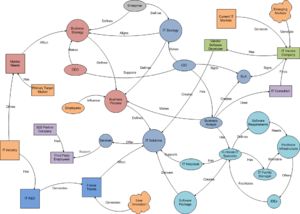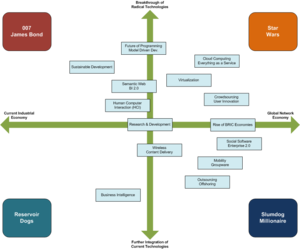The future of Enterprise IT
Team members
- Giorgos Roussakis
- Reyner Karnali
- Christian Wittenberg
- Adi Kentsch
Introduction
Information Technology represents a crucial asset to business, being regarded as the backbone of most corporate companies worldwide. Enterprise IT underwent major developments by improving business processes and adding strategic value to businesses. Its increasing complexity however started to backfire and put further developments in difficulty. In a fundamental basis the concept behind IT remained the same, data manipulation. The emergence of collaborative/integrative web services is expected to reduce this complexity, shaping the future of Enterprise IT. However, this approach is not a panacea. We shall explore various scenarios, that will include Semantic Web, Business Intelligence, Work Streaming, Information Engineering, Human-Computer Interaction and Service networks, to name but a few.
Research Questions
Defining Enterprise IT
- What is Enterprise IT?
- What are legacy systems?
- Any common global standard for Enterprise IT?
- How do you categorize and/or classify Enterprise IT?
- How long does it take for firms to implement these solutions (e.g. ERP system)?
Technologies
- Artificial Intelligence with Enterprise IT?
- How does the emergence of virtualization impact Enterprise IT?
- What are the Impacts of Internet in the future development of Enterprise IT?
- What are interesting technologies for improving the way Enterprise IT is applied
- Why is the Hardware keeps on improving rapidly, while software not? What is fundamentally different?
Financial and Economic
- What is the GDP market for enterprise IT?
- What is the average cost that firms pay for implementing Enterprise IT (in this case, ERP)?
Market & Environment
- Who are the Primary Target Markets?
- Who are dominating the Enterprise IT industry?
- How does Enterprise IT affect the organization?
- What are relevant trends that influence the future of enterprise IT?
- How will Outsourcing of Enterprise IT will develop in time?
Problems
- What are the problems of current Enterprise IT?
- Does user experience matter in Enterprise software? What are the caveats?
- How catastrophic will the future development of programming language will be for Enterprise IT (Impact of it)?
Solutions
- What are known solutions to solve Legacy problems in Enterprise IT?
- How can consolidation of solutions be beneficial?
- What is the most viable future of Enterprise 2.0 ?
Driving Forces
Technological forces
- Programming Languages
- Cloud Computing and the Enterprise
- The innovative Open alternative
- The shift towards Semantics in Business Intelligence
- Content Delivery in Location Aware Applications from converged 3G/Wireless Internet
- Increasing Human-Computer Interaction
Social forces
Economical forces
Systems Diagram

Meaning of colors and shapes:
Gray The Enterprise
Purple Business Core
Navy Blue IT Core
Aqua Blue In-House IT
Deep Blue External IT
Indigo B2B Partner
Green Outsourcing Party
Orange Key Enablers
Big Circle Internal Feature
Small Circle Assist Feature
Square External Feature
Oval Internal Role
Rectangular External Role
Cloud Intangible Presence
The key enablers identified on the Enterprise IT systems diagram happen first of all at a technological level and second of all at a social and economical level.
Technological factors are represented by the IT industry and their R&D programs, but also by demand from the primary target market and by user innovation coming from the Internet cloud.
Social factors are represented by company employees and by social interactions that take place on the Internet between customers and between lead-users.
Economical factors are represented by the choice enterprises have when trying to discover the best solution for their IT development. This can either happen in-house, can be outsourced or offshored, or can be a combination of options. Furthermore, outsourcing/offshoring can be done either with current IT markets, mostly Western, or with emerging markets, such as the BRIC, the decision depending on socio-economical aspects.
Scenarios
Supporting our discovery of six technological driving forces and six socio-economical driving forces, three for each, the systems diagram points out that four scenarios could possibly emerge, given the extent to which enterprises embrace on the one hand technological change and on the other hand socio-economical change, as presented below:
